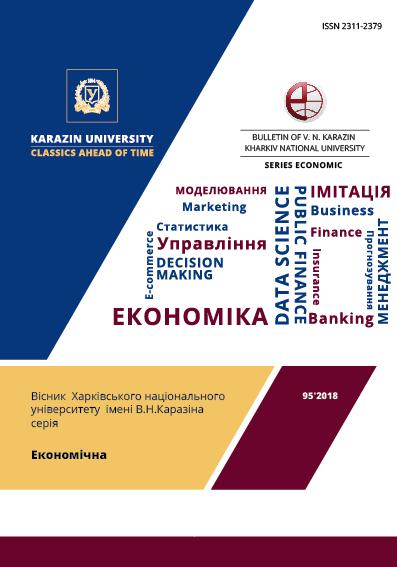Evolution of concepts of personnel competence development
Abstract
This study was conducted through the importance of linking the concepts of corporate learning organization among themselves and a small number of published research on this issue. The answer to this question will allow the heads of the corporate learning departments to better assess their own units, select the necessary forms of development, and effectively associate them with the corporate LMS (learning management system), as well as formulate a strategy for developing training tools with a focus on more recent ones.
In order to realize the corresponding task - methods of analysis and synthesis were used, a review of existing formats and forms of development of professional competencies was conducted, a survey of specialists and managers of IT companies in Kyiv was conducted and the obtained results were analyzed.
The paper examines the evolution of modern concepts of staff competence development and highlights the main stages: e-learning, mixed learning, lifelong learning, digital learning. The main formats are considered, in which the tools of competence development of the personnel are used: traditional formats, corporate university, corporate e-university, experimental training, macro education, micro curriculum. The definition of such formats as macro education and experimental learning is proposed.
The description of tools for development of professional competencies is presented: MBA, conferences, articles, certifications, books; trainings, cinema clubs, quests; coaching, mentoring, rotation, coaching, buddying, shadowing, statement; MOOC; video channels, mutual learning, chats in soc. networks, SMS-training.
The role of the learning management system (LMS) in each of the described concepts has been investigated, and the conformity of traditional forms of learning with their analogues with the use of information technologies is indicated.
The main result of the study is the developed model of the evolution of the concepts of competence development within corporate learning.
Downloads
References
Goulman D., Bojacis R., Makki Je. (2015) Emotional leadership: the Art of managing people based on emotional intelligence M.: Al’pina Pablisher, 301.
Shtutman, P. (2010). Personnel Professional Development as a Factor of Enterprises’ Activity Efficiency Increasing. Naukovi pratsi KNTU. Ekonomichni nauky, (17), 159-163.
Plugina, Yu.A. (2013), "The development of personnel, approaches, essence, models", Visnik ekonomiki transport i promislovostiі , (42).
Markova, N. (2010). Principles, functions and models of development management personnel. Efektyvna ekonomika, (9).
Halaida, T. O. and Savytska, I. M. (2011), “Training, retraining and qualification improvement of personnel at enterprises in modern conditions”, Ekonomika i rehion, (2), 118-121.
Makeieva, I. (2012). Organization of system of professional development of staff of libraries of higher educational institutions of Ukraine: history and current state. Bulletin of book chamber, (6), 12-16.
Rosenberg, M. J., &Foshay, R. (2002). E‐learning: Strategies for delivering knowledge in the digital age. Performance Improvement, 41(5), 50-51.
Welsh, E. T., Wanberg, C. R., Brown, K. G., & Simmering, M. J. (2003). E‐learning: emerging uses, empirical results and future directions. international Journal of Training and Development, 7(4), 245-258.
Driscoll, M. (2002). Blended learning: Let’s get beyond the hype. E-learning, 1(4), 1-4.
Klamma, R., Chatti, M. A., Duval, E., Hummel, H., Hvannberg, E. T., Kravcik, M., ... & Scott, P. (2007). Social software for life-long learning. Educational technology & society, 10(3), 72-83.
Warschauer, M. (2007). The paradoxical future of digital learning. Learning Inquiry, 1(1), 41-49.
Vovk, O. B. (2015). Системи електронного навчання–нові форми сучасної освіти. Mathematical Machines and Systems, (3), 79-86.
Bersin, J. (2004). The blended learning book: Best practices, proven methodologies, and lessons learned. JohnWiley&Sons.
Friesen, N. (2012). Report: Defining blended learning. LearningSpace.
Shin, J. H., Haynes, R. B ., & Johnston, M. E. (1993). Effect of problem-based, self-directed undergraduate education on life-long learning. CMAJ: Canadian Medical Association Journal, 148(6), 969.
Lombardo, M. M., & Eichinger, R. W. (1996). The career architect development planner. Lominger p. iv, 1st ed. Minneapolis.
El-Tannir, A. A. (2002). The corporate university model for continuous learning, training and development. Education+ Training, 44(2), 76-81.
Kurbatov, S. (2014). Corporate University as a product of interaction between business and educational environment in modern conditions. Vy`shha osvita Ukrayiny, 3(54), 44-49.
Plugina, Ju.A (2013). Modern methods of professional staff development. Vіsnik ekonomіki transportu і promislovostі, (43), 249-254.
Bugaychuk, K. L. (2017). Microlearning: concept, features, benefits. Distance learning - Start from the present to the future: collection of scientific and methodological works ІІІ All-Ukrainian sciences-practice. conf. from international participation (Kharkiv, 20 april 2017 ), 28.
Reznik, V., & Melnik, T. (2017). Microlearning as a promising method of training highly skilled specialists. Humanitarium, 39(2), 71-77.
Liyanagunawardena, T. R., Adams, A. A., & Williams, S. A. (2013). MOOCs: A systematic study of the published literature 2008-2012. The International Review of Research in Open and Distributed Learning, 14(3), 202-227.
Vardi, M. Y. (2012). Will MOOCs destroy academia?. Communicationsofthe ACM, 55(11), 5-5.
Singh, H. (2003). Building effective blended learning programs. Educational Technology-Saddle Brook Then Englewood Cliffs NJ-, 43(6), 51-54.

